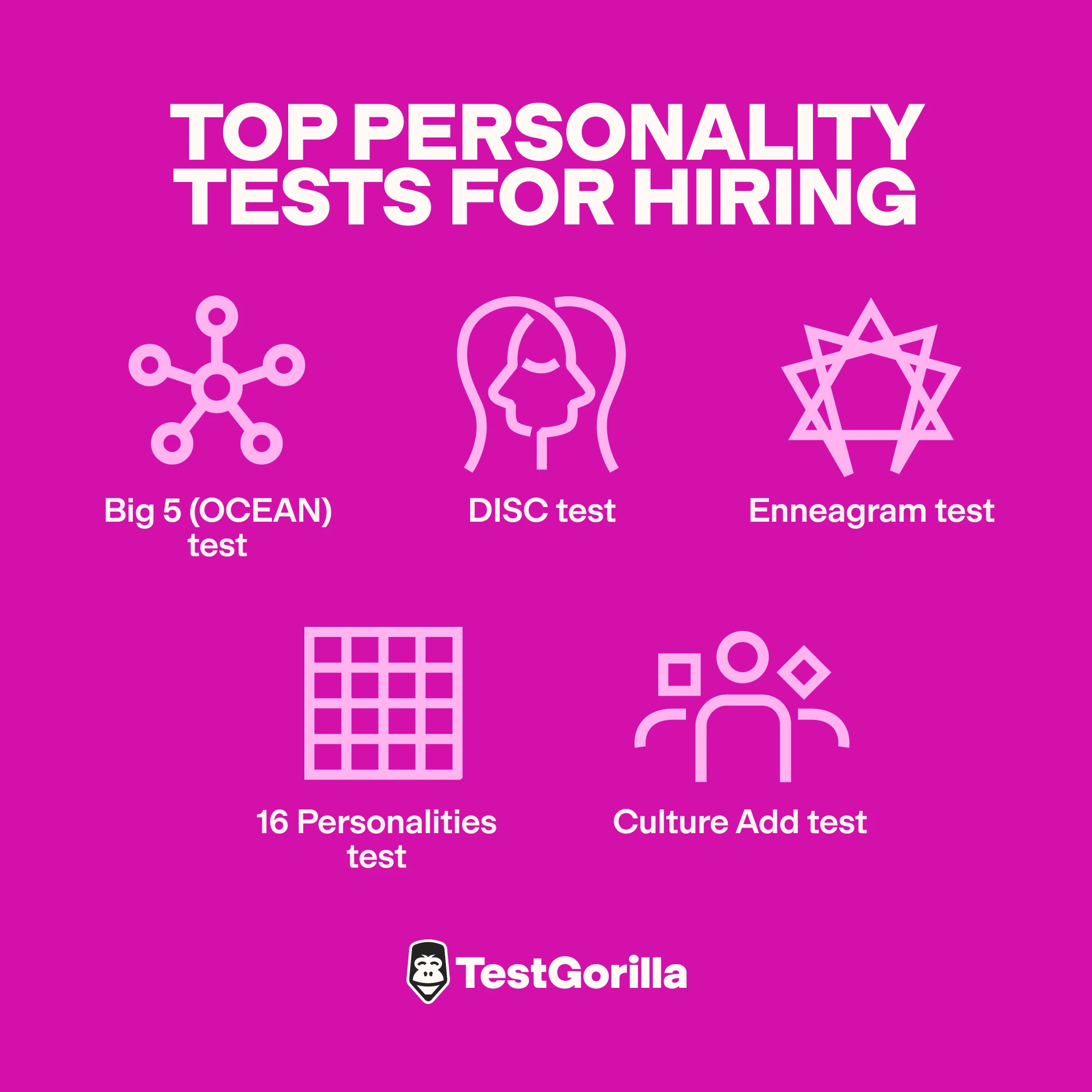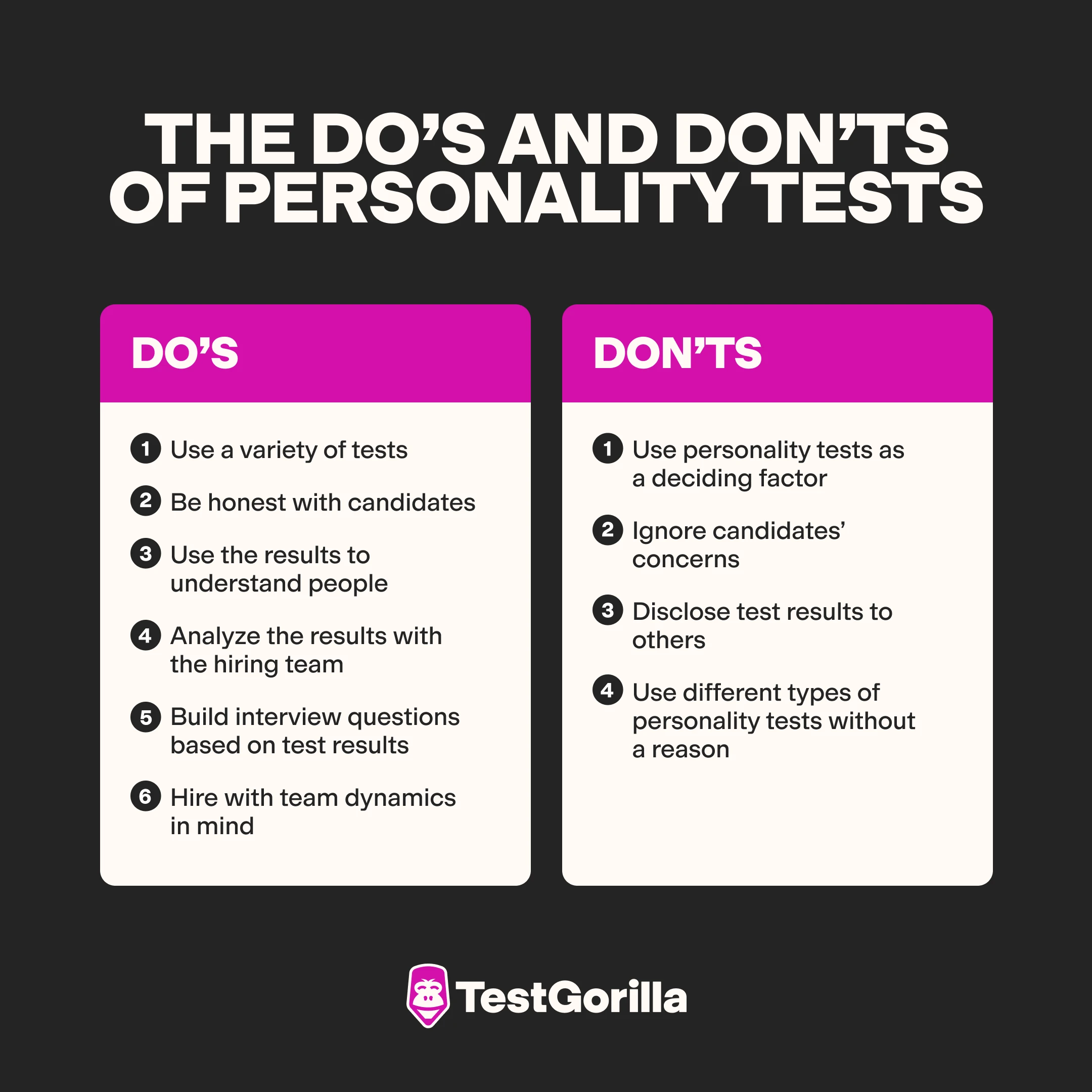Use personality traits to build an exceptional team
The best personality test for hiring helps you understand job candidates’ traits and behaviors – it also shines a light on what drives candidates to succeed.
Although they shouldn’t replace the skills-based decision-making process, personality tests can help recruiters form insightful interview questions and find the best match among shortlisted candidates.
Using personality tests for hiring is a great idea, but you need a solid plan to do it properly. This guide discusses the benefits of personality tests, which ones to use, and how to weave them into the best recruitment process.
Table of contents
- What are personality tests?
- Why should you add personality tests to the recruitment process?
- What are the best personality tests for hiring?
- The do’s and don’ts of personality tests
- How to add personality tests to your hiring strategy in five steps
- Choose the best personality test for recruitment with TestGorilla
- Using personality tests for hiring FAQs
What are personality tests?
A personality test for hiring is an assessment that identifies a candidate’s traits, preferences, and work style. They’re often multiple-choice self-evaluation tests where candidates choose which traits or statements apply most to their personality.
Based on the results, you can get a better understanding of a candidate’s underlying characteristics like motivations, communication style, temperament, character, and personal identity.
For example, a personality test can reveal how someone prefers to interact with others, their preferred way of handling a stressful situation, or how flexible they are to change.
Using personality tests for hiring is often controversial because they can introduce bias into your decision – but that’s only if they’re used improperly. These pre-employment assessments provide excellent insights when used as a part of a fair skills-based hiring process.
You may also like: Personality hires are candidates hired specifically for their personalities. Learn more about making personality hires here.
Why should you add personality tests to the recruitment process?
Using a personality assessment test for hiring can be extremely helpful to hiring managers. They support the recruitment process in five crucial ways:
Reduce hiring bias
Compare top candidates
Help you make data-driven decisions
Explore personality rather than past behavior
Minimize turnover
Let’s explore these points in greater depth.
1. Reduce hiring bias
Personality assessments encourage objectivity, helping recruiters understand a candidate’s traits without the interference of unconscious bias.
And because they’re self-evaluations, these tests help you understand a candidate from their own point of view.
It’s nearly impossible to assess someone’s personality solely from a short interview process, and one interviewer may get a different idea of a candidate’s traits than another interviewer in the same room.
However, personality tests bring consistency to assessing each person. Evaluate them with assessments, and then use scripted interview questions to get a full picture of each and every candidate.
2. Compare top candidates
Personality tests can emphasize finer differences. If multiple candidates have similar qualifications, then personality assessment tests can help you identify the right pool.
For example, personality assessments can help you shortlist customer service candidates. Move certain candidates forward based on their personality traits, like being more comfortable with people, open to other opinions, and patient.
Although making a final decision based on human personality isn’t a good idea, it can help you narrow your decision when faced with multiple, equally talented candidates.
3. Help you make data-driven decisions
Data-driven recruitment is a powerful way to access actionable insights that lead to a more consistent decision-making process.
Although some experts have criticized hiring based on pre-employment personality tests, claiming they’re not accurate predictors of job performance, that’s only when they’re used on their own.
In combination with other skills tests, like cognitive ability tests, personality assessments provide you with unbiased data that helps you choose the right candidate effectively and efficiently.
This also speeds up the hiring process because you can review candidates at a glance from a technical dashboard, rather than relying solely on notes from job interviews.
Make data-driven decisions with TestGorilla
Review candidates’ personalities by quickly comparing test results, leading to objective, consistent recruitment. See this in action by booking a demo with one of our friendly experts.
4. Explore personality rather than past behavior
For many recruiters, personality assessments focus on past behavior, rather than firm traits. However, this is problematic because people can change or adapt their behavior. For example, someone who’s naturally disorganized can develop habits to keep themselves organized.
Often, a person’s behavior is the tip of the iceberg. Their deeper personality dictates how they react to new situations, but it’s often beneath the surface and difficult to understand without using personality tests.
For example, a sales representative who smoothly answers behavioral questions may get the job, while an introverted salesperson gets passed over despite them being a better hire because of their listening skills – but this doesn’t show in a hiring process without assessments.
5. Minimize turnover
Finding and using the best personality test for hiring helps you find more suitable candidates, increasing retention and reducing overall turnover.
Personality impacts work life significantly. Without understanding how a person works, you could quickly run into issues like miscommunication, which affects team performance and employee satisfaction.
These tests discover new hires who are well-suited to your company and open roles. For instance, if a candidate struggles with sudden change and adaptability, they wouldn’t be ideal for a fast-paced sales environment and may end up quitting after only a few months.
Personality assessments let you hire the best candidate the first time. See the impact skills tests can have on your hiring budget by using our Recruitment ROI Calculator.
The best insights on HR and recruitment, delivered to your inbox.
Biweekly updates. No spam. Unsubscribe any time.
What are the best personality tests for hiring?
Let’s take a look at the top five personality tests for hiring. Remember that although these are commonly called behavioral assessments, they don’t always focus on past behaviors, and usually gauge traits, workstyle, and preferences.
Here’s a quick summary of our favorite personality tests:
Personality test | Description |
16 Personalities test | Evaluates a person’s lifestyle preferences, world perception, and how they process information |
Culture Add test | Shows how well a candidate aligns with your company’s cultural values |
Enneagram test | Assesses a test taker’s core beliefs |
DISC test | Gauges how a candidate interacts with others |
Big 5 (OCEAN) test | Evaluates five primary personality traits, including openness and conscientiousness |
Below, discover more details about each personality test and how they help you make better hiring decisions.
16 Personalities test
The 16 Personality Types test is based on the Myers-Briggs Type Indicator, also called the official MBTI 16 Personality test. It’s a questionnaire that measures the different ways in which people perceive the world, problem-solve, make decisions, and process information.
Many believe this assessment is the best personality test for recruitment, and it’s certainly the most popular.
What it measures: Assigns candidates one of 16 possible personality archetypes, made up of four letters each. These letters represent eight different words, grouped into four dichotomies:
Introversion (I) or Extraversion (E)
Intuition (N) or Sensing (S)
Feeling (F) or Thinking (T)
Judging (J) or Perceiving (P)
What it’s for: Helps you understand motivators, strengths, and weaknesses.
For example, an INFJ is an introverted, judging type, which makes them well-organized, thoughtful, and great with people. However, they don’t get their energy from large groups of people, so they’re ideal as HR managers, who often interact with employees in quiet one-on-ones.
Culture Add test
Our Culture Add test is a unique, personalized assessment that gauges how an applicant’s values and interests align with your company’s values based on a customized survey you fill out.
What it measures: Assesses how a person aligns with your organizational culture. Company culture describes your organizational values and work style. It’s about how people see your leaders, how team members interact, and how your company mission is woven into work.
What it’s for: Enables you to gauge crucial factors, like whether or not a candidate needs strict independence, without leaning on old-fashioned “culture fit” evaluations, which can lead to biased hiring decisions.
Your culture is essential and heavily contributes to the success of your people strategy – 55% of workers say they would leave a new job if the culture didn’t align with their expectations and values.
Enneagram test
The Enneagram test defines nine personality types that refer to different worldviews and core beliefs.
What it measures: Gauges a candidate’s communication and work style, as well as their approach to interpersonal relationships.
What it’s for: Helps you understand how potential employees handle interpersonal situations, how they build relationships, and what drives them forward. This information helps you strategically assemble teams and build effective communication strategies.
Recommended reading: How to interpret your candidates’ Enneagram types
DISC test
The DISC test is an assessment that gauges candidates on four core personality traits: dominance (D), influence (I), steadiness (S), and conscientiousness (C).
What it measures: Evaluates how candidates interact with other people by measuring their dominance, influence, steadiness, and conscientiousness, and placing them into one to two categories, such as S or DI.
What it’s for: Helps you understand how a candidate collaborates with others and works in team settings. It also gives you an idea of how motivated they could be in your open role. For example, DI types work well in executive positions owing to their charisma and authority.
Big 5 (OCEAN) test
The Big 5 (OCEAN) test is based on the five-factor model (FFM) theory, which posits five broad domains as the basis of different personalities.
What it measures: Gauges people on five main trait dimensions:
Openness (O)
Conscientiousness (C)
Extroversion (E)
Agreeableness (A)
Neuroticism (N)
The test assesses where candidates fall on each scale. For example, Extrovert to Introverted.
What it’s for: Knowing a person’s traits, such as their agreeableness, helps you assemble a strong team, build a healthy company culture, and match a candidate to a role or organization.
For example, someone with high “openness” is likely to adapt to change more easily than others. This is essential in a fast-paced, changeable work environment.
Start testing today with TestGorilla
Gain unlimited access to the Big Five (OCEAN) test with our Free forever plan. Sign up and start understanding your candidates’ personalities today.
The do’s and don’ts of personality tests
With the right strategies, we can avoid the issues, reap the benefits, and reframe the narrative around personality tests.
Here are the top do’s and don’ts of using an online personality test for hiring:
Do’s | Don’ts |
- Use a variety of tests - Be honest with candidates - Use the results to understand people - Analyze the results with the hiring team - Build interview questions based on test results - Hire with team dynamics in mind | - Use personality tests as a deciding factor - Ignore candidates’ concerns - Disclose test results to others - Use different types of personality tests - without a reason |
Let’s get a bit more in-depth into each, starting with the do’s:
Use a variety of tests: Use personality tests in combination with other tests. Personality tests are best used as part of a complete skills assessment, so you can get an accurate, whole picture of each person.
Be honest with candidates: Give your candidates context and explain why you’re using personality tests as a part of your hiring process. Explain that you aren’t looking to hire a certain personality type, but simply to better understand them and build a strong, diverse team.
Use the results to understand people: Learn peoples’ personalities to create communication strategies and build trust, not make final decisions.
Analyze the results with the hiring team: Although it’s not recommended to share the results with anyone not involved in the recruitment process for this specific role, sharing them with your hiring team can help them better understand the candidates they’re interviewing.
Build interview questions based on test results: Use personality test results to prepare talking points in advance of interviews. For example, someone may assess themselves as impatient, but that isn’t always negative. Impatience may result in quick decisions and delegation.
Hire with team dynamics in mind: Use personality tests to thoughtfully consider team dynamics. For example, in certain scenarios, a mix of personalities may foster innovation.
Here are the details on the don’ts:
Use personality tests as a deciding factor: Never use personality tests as a final deciding factor because it could open you up to discrimination or biased hiring. Plus, studies show that motivations, attitudes, and views change over time, so it’s best to use results to help you understand someone rather than making crucial decisions with them.
Ignore candidates’ concerns: Listen to candidates and carefully consider their feedback. If certain personality tests are intimidating to many of your candidates, then you might need to rethink whether you should use them in the future.
Disclose test results to others: Results are not meant to be shared with others or discussed with team members, for example. They are confidential and you shouldn’t share them with anyone who isn’t a part of the hiring process.
Use different types of personality tests without a reason: By using the same personality test throughout the company, you create a common language that enables you to point out certain behaviors in a neutral, constructive way. If everyone has done a different personality test, you lose that benefit.
Now that you know how to effectively use a personality test for hiring, let’s determine how to work them into your recruitment process.
How to add personality tests to your hiring strategy in five steps
Although it’s challenging to build a solid hiring process that features personality assessments, following this guide helps you successfully implement these tests and hire the best.
1. Determine your goals
The first step in implementing personality tests is to decide which one would work best for your company.
Consider which personality test asks the most relevant questions. For example, if you’re interested in gauging employee integrity and temperament, you would use the DISC test. But if you were more interested in their interpersonal style, you could give them the Enneagram test.
To learn more about which tests are the most relevant for your role, consider checking out our comparison guides, like our article on Enneagram vs. 16 Personalities.
2. Choose the right tests for your assessment
The best personality test for hiring is one in a multi-measure assessment. Multi-measure testing is the practice of assessing multiple factors at once, including cognitive abilities and role-specific skills.
For example, a multi-measure assessment for a sales representative could include:
Big 5 (OCEAN) test
Negotiation test
B2B Outside Sales test
Salesforce test
Culture Add test
Combining five talent assessments helps you easily identify top talent for your organization, giving you a complete overview of each of your candidates’ skills, behavior, and knowledge.
3. Integrate them into your recruitment process
Now, choose which stage of the hiring process to use talent assessments. We recommend conducting tests before everything, including screening resumes, assessing LinkedIn profiles, or interviewing candidates.
This lets you pre-screen applicants and invite only the best ones to an interview, while at the same time, you’re also ensuring qualified candidates aren’t filtered out because of their resumes only.
For example, traditional resume screening may omit candidates without a certain college degree, even if they’re qualified through other means, like coding boot camps.
4. Review results and inform the interview
Once you’ve shortlisted the best job applicants based on their knowledge and skills, analyze the results of the personality test.
The results of your skills and personality assessments help you ask targeted interview questions about how candidates would handle certain workplace situations. The more you know about a person, the better questions you can ask.
For example, if they are introverted, prepare follow-up questions to assess their level of introversion and ascertain how they behave in a team setting.
5. Make a decision and extend an offer
The final step – decide which candidate is best, and hire them.
Of course, as previously mentioned, don’t rely only on the results of the personality test to make your final decision. Simply use it as a tool to understand and get to know your candidates and future employees a bit better.
You can also adapt onboarding, training, and management to them and their personality traits to be more efficient and help them achieve greater success.
See how talent assessments transform recruitment
Use talent assessments to screen candidates and reduce turnover, increase hiring speed, and hire the right people the first time. Experience the power of a skills-based recruitment process by booking a demo with one of our experts.
Choose the best personality test for recruitment with TestGorilla
Using a personality test for hiring is a great way to secure top talent: It lets you gain a better knowledge of your candidates, build diverse teams, and improve your organizational culture.
Our personality tests all work in different ways to give you insight into your applicants’ personality traits, from gauging interpersonal skills to discovering cultural alignment. Jump straight into the action by trying the Big 5 test in our Free forever plan.
Or book a demo with one of our skills tests experts to learn more about using personality tests for hiring and how to incorporate them into the ideal recruitment process.
Explore our product tour to learn about skills-based hiring and how skills tests reduce hiring costs, improve efficiency, and screen better candidates.
Using personality tests for hiring FAQs
Let’s finish by answering a few questions about using personality tests for hiring.
How are personality tests used in the hiring process?
When personality tests are used properly, they give you insights into a candidate’s work style, core beliefs, and motivations. This helps inform your communication strategies and build stronger teams. However, ensure you never use personality tests to make your final hiring decision because it could introduce unfair biases.
Why do HR professionals use personality tests?
Human resource professionals use personality tests during recruitment to build better interview questions and learn more about future employees. They can also be a useful tool to shortlist equally qualified applicants.
Is it legal to use personality tests for hiring?
Yes, it’s legal to use a personality assessment test for hiring new employees. However, it’s vital to ensure tests don’t discuss race, color, religion, gender, nationality, and disability because these factors introduce legal issues.
Disclaimer: The information contained on this webpage is provided for informational purposes only and should not be construed as legal advice on any subject matter. If you have any questions on illegal personality tests in your area, please consult with a lawyer.
You've scrolled this far
Why not try TestGorilla for free, and see what happens when you put skills first.























